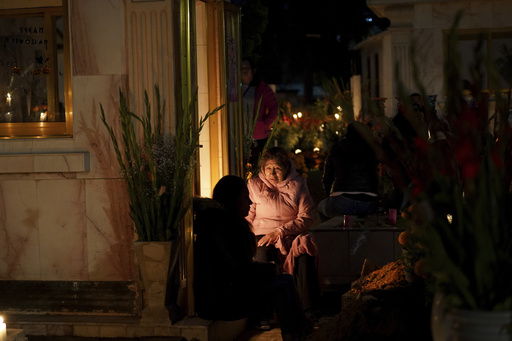
MEXICO CITY — As midnight approaches in the outskirts of Mexico City, the San Gregorio Pantheon is buzzing with life and energy.
The sounds of mariachis fill the air as families gather to decorate the graves of their cherished ones with flickering candles, vibrant cempasúchil flowers, and beloved treats such as pan de muerto and Coca-Cola.
Every year, at this time, Mexico bursts into a vibrant celebration known as the Day of the Dead. Families flock to cemeteries nationwide on November 1 to reconnect with their deceased, just as generations before them have traditionally done.
In smaller communities like this one, maintaining the essence of their customs is essential as larger cities see their festivities increasingly influenced by mass tourism.
“We’re preserving our tradition, a part of our heritage that my mother passed down to me,” shared 58-year-old Antonio Meléndez. “We must keep it alive.”
Meléndez was one of the many people gathered at the cemetery, located in the intricate networks of canals and brick structures in Xochimilco, a borough in southern Mexico City known for its rich customs that remain vibrant while fading in other areas of the country.
He stood with his two daughters by the grave of his mother, adorned with orange petals arranged in a cross and bouquets of pink flowers, symbolizing her favorite color.
Having lost her just last year, Meléndez finds solace in nurturing memories of her by adhering to the rituals he observed growing up, this time with his daughters by his side. He prepared for the observance by making tamales from scratch and assembling a small altar for her in their home several days prior.
The Day of the Dead has roots that stretch back centuries, originating with ancient Indigenous cultures that held celebrations upon a person’s death to guide their spirit to the afterlife. They would create altars filled with food to provide sustenance during that journey, according to the Mexican government.
The government notes, “During the Day of the Dead celebration, death is not viewed as an absence but rather as a living presence; it symbolizes life manifested through altars.”
Following the arrival of Spanish colonizers who enforced Catholicism upon Indigenous groups, these communities began blending their traditions with Catholic celebrations, resulting in commemorations of the dead aligning with All Saints Day on November 1, concluding on November 2.
While the celebrations intensify leading up to the end of October, Mexican tradition holds that on that evening, their departed are the closest to the living, and people strive to maintain their company in various ways. Each family has its unique way of commemorating the occasion.
Within the San Gregorio Pantheon, older women carry large bundles of striking orange flowers, the quintessential flower of death, while some families comfort each other as they grieve. Others find solitude beside the graves of their loved ones in reflective silence, and many share drinks of mezcal while recounting stories about their family members.
Beatriz Chávez, 60, kneels at the graves of her son, nephew, and father, calmly lighting candles alongside her daughter and granddaughter.
“It’s like being with them one more year, feeling that even if they cannot see us, we feel closer to them,” shared Chávez, who plans to spend the night in the cemetery, a tradition she has kept alive since her father passed away when she was ten.
The Day of the Dead tradition gained international recognition through the Disney movie Coco, and a parade presented in Mexico City found its way into a James Bond film, despite the lack of such an event occurring historically. Recently, however, actual celebrations have embraced the parade concept inspired by the film.
In the present day, visitors from various countries have come to experience this cultural celebration firsthand.
Nevertheless, the once intimate observances in prominent Day of the Dead locales, such as Mexico City, Oaxaca, and Michoacán, have started to swell with tourists eager to capture moments with mourners. Recently, the blending of the Day of the Dead with Halloween has emerged, with some new traditions, like the James Bond-inspired parade, also beginning to take root.
Individuals like Meléndez have voiced their concerns about these transformations.
“Here, Halloween is not our celebration; it’s the Day of the Dead,” he lamented. “It’s disheartening because it feels like we’re losing the true essence of who we are. This is our identity and our roots.”
For Meléndez, this celebration in their smaller cemetery carries added significance, as he and his peers believe it honors the timeless customs that have persisted through the centuries.
These changes also coincide with a larger discussion happening across Mexico as an influx of American expatriates and tourists transforms the landscape. Rising rents in Mexico City have pushed many locals out of neighborhoods they have inhabited for years, leading to a simmering frustration among residents.
Those roaming the graves and selling flowers and food perceive the shifts less as a degradation of tradition and more as an evolution—a way for younger generations to pass on their heritage in new forms and share their customs with different audiences.
For mourners like Chávez, who celebrated alongside her family, modern technology added a new layer to their observance as they used iPhone lights to assist in decorating the graves.
“It’s beautiful that people from other places are taking an interest in our culture. I think celebrating our love for our deceased and honoring death is crucial—it’s important for them to understand our roots and traditions that continue to flow from generation to generation,” declared her daughter, 36-year-old Ana Laura Anell Chávez.
